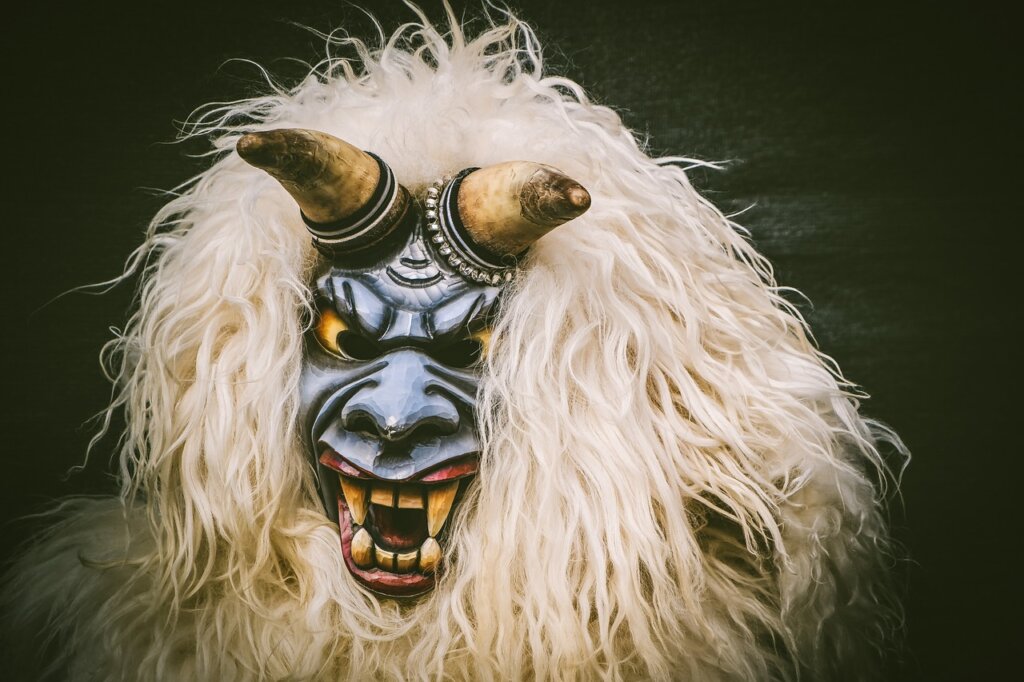Ranking the 12 scariest Japanese Yokai from Japanese folklore and mythology. From the fearsome, red-skinned Oni to the bird-like Tengu spirits.
Welcome to our exploration of the mesmerizing world of Yokai, the demons and monsters of Japanese folklore and mythology.
These spooky and mysterious creatures helped early Japanese society to explain the unexplained. Yokai monsters have influenced the realms of anime and film with popular franchises like Pokemon being inspired by their timeless tales.
Here are the top 12 Yokai from Japanese folklore and mythology.
12. Kitsune
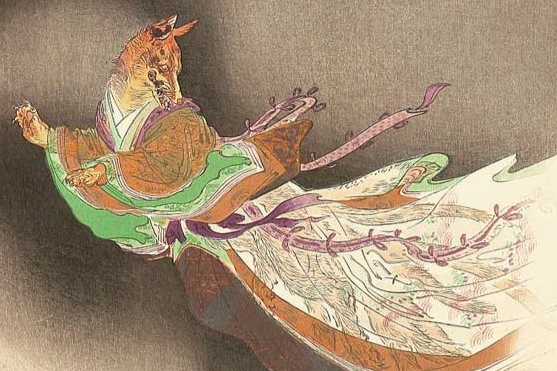
Related article:- 10 terrifying Japanese urban legends worth the nightmare
Kitsune are fascinating and enigmatic Yokai, often depicted as foxes with supernatural Powers. While they typically appear as ordinary foxes, they have the ability to shape and shift into human form.
Kitsune is known for its striking red or white fur in multiple tales, which signifies their age and power. They have inspired many great moments in popular culture. Kitsune are celebrated for their intelligence and magical abilities.
They are renowned shapeshifters capable of transforming into beautiful women or men to interact with humans. They are often mischievous, and known for punishing and playing pranks on wicked or greedy humans.
The older and wiser a kitsune, the more tales they possess, with nine being the maximum. Countless stories and legends feature kitzene showcasing their complex nature.
One well-known tale tells of a kitsune who Falls in love with a human and transforms into a woman despite their deep affection. The kitsune’s true nature is eventually revealed, and the fox wife can then only return to their lover under the cover of night, every night.
11. Ningyo
Related article:- 11 scariest mythical creatures from Philippines
Ningyo, often referred to as mermaids, but they can also be mermen, are legendary aquatic creatures in Japanese folklore.
These beings bear a striking resemblance to humans from the neck up but have the lower body, and sometimes in contrast, to western mermaids, the chest of a fish with just a human head.
Ningyo were often said to have been caught by fishermen, pleading for their release. I guess, one would be sympathetic enough to release it.
Unfortunately, in one of the most famous tales regarding these mer-creatures, a young girl refused to release the Ningyo and instead cooked and ate her.
The girl then received everlasting youth and became the nun, Bikuni Yao, who is said to have lived for 800 years, never aging.
10. Yama Uba
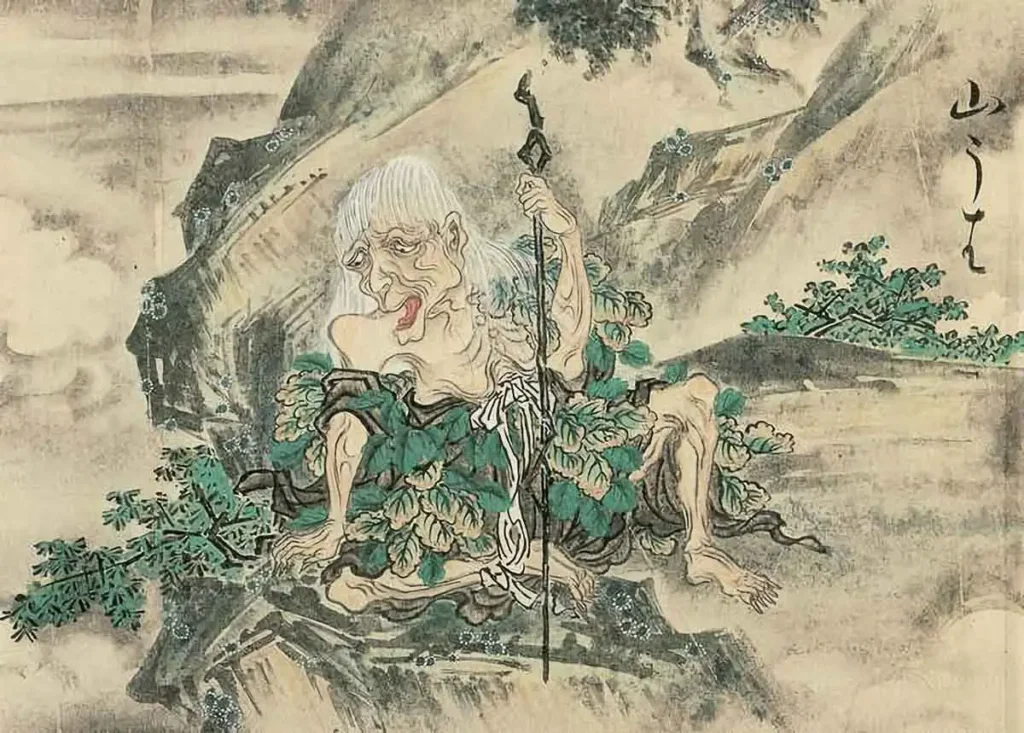
Related article:- 10 spine-chilling creatures from Malaysian mythology
The Yama Uba, also known as the dame of the mountain, is depicted as an elderly hag with long disheveled white hair and a gnarled, marked body. Her appearance is a stark reflection of the harsh mountain environment she inhabits.
Yama Uba is usually seen wearing tattered clothing, giving her an eerie and unsettling appearance. Similarly to the Slavic baba yaga character, Yama uba is portrayed as a fearsome, aged creature living an isolated life in the mountains.
She captures and devours unfortunate travelers who have lost their way in the wilderness. Serving as a chilling warning to those who dare to venture too deep into the mountains.
9. Tengu
Related article:- 10 terrifying urban legends that turn out to be true
Tengu are fascinating and elusive Yokai, often depicted with human and bird-like features. They possess humanoid bodies with striking red faces, long noses or beaks, and the ability to fly with feathered wings.
Tengu can be both helpful and mischievous, evoking both awe and fear. Tengu are renowned for their martial prowess, with expert skills in martial arts and swordsmanship. They have a mythical king called Sojobo who has the strength of 1000 tengu and trained the famed swordsman Minamoto no Yoshitsune in warfare and magic so that he became as strong as a Tengu.
Tales of tengu are abundant in Japanese folklore. One story of helpful tengu is regarding the brave archer in samurai, Minamoto no Tametomo, who it is said was powerful enough to sink a ship with a single arrow.
In this story, he decides to escape his exile and sail to Kyoto, but a huge storm appears with a giant fish threatening to eat him and his son. But several tengus saw this and came to his rescue, saving him from the jaws of the giant fish.
8. Tsuchigumo

Related article:- 10 creepiest Viking myths and legends
Tsuchigumo, often translated as ground spiders or dirt spiders, are mythical creatures that take the form of enormous spiders. These Yokai are known for their grotesque appearance, with oversized bodies covered in coarse hair and menacing beady eyes.
Tsuchigumo are renowned for their cunning and intelligence. They are known for their ability to manipulate and control their surroundings. Legends depict them as masterful illusionists, capable of creating illusions to ensnare and deceive their prey.
The famous Japanese warrior, Yorimitsu Minamoto, is said to have slain one of the Tsuchigumo with his long sword after it attempted to poison him, in the guise of a young servant boy.
5. Nekomata
Related article:- 10 most famous witches around the world
The Nekomata are supernatural entities that appear as domestic cats with one striking difference. They possess two tails or a single forked tail, making them distinguishable from their ordinary feline counterparts.
Often depicted in paintings as bards with musical instruments, Nekomata are typically found in rural areas and are closely associated with traditional Japanese households.
They are believed to reside in the homes of their owners as domestic cats, but their true nature becomes apparent when they age and transform into Yokai, and gain strange powers in an attempt to abduct and eat humans.
Nekomata is often associated with various mystical Powers, including the ability to manipulate fire and spectral abilities. Some legends even suggest that they can speak human language or possess the power of necromancy, allowing them to raise the dead.
6. Yuki Onna

Related article:- 10 terrifying versions of boogeyman around the world
Yuki-onna, which translates to snow woman, is a haunting figure from Japanese folklore. She is often depicted as a beautiful woman dressed in flowing white robes that blend seamlessly with the snow-covered landscape around her.
Yuki-onna possesses the chilling ability to control ice in cold temperatures. She is known to appear on cold, snowy nights, and her mere presence can freeze the air around her. She has the power to create blizzards and icy gusts of wind.
Yuki-onna is also said to have a mesmerizing, hypnotic beauty that can draw lost travelers closer to her and devour their life force in the snowy, Kaminoyama region of Yamagata. There’s a tale of a Yuki-onna who sought warmth from an elderly couple’s hearth.
On a wintry night, she graciously shared their home. But when she decided to leave on her journey, late at night, the old man reached out to stop her.
To his shock, her touch was bone-chillingly cold. And before his very eyes, she transformed into a swirling vortex of snow and vanished from the house.
5. Kappa

Related article:- 10 scariest urban legends around the world
The Kappa are fascinating creatures and one of the most recognizable Yokai. They are characterized by their reptilian appearance, resembling monkey-like or humanoid turtles.
They have a distinctive saucer-shaped depression on the tops of their heads, which holds a pool of water, the source of their power. Kappa is usually depicted with greenish-blue skin in webbed hands and feet.
Kappa are renowned for their love of water and their incredible strength. And they love engaging in sumo-style wrestling, matches, in rivers and lakes, they derive their strength from the water and the depression on their heads, which is their life force.
If the water spills, they become weak and may even die. Kappa are also known for their mischievous nature and have a tendency to play pranks on humans. One famous tale involving kappa is the story of a clever boy who outwitted a Kappa by bowing deeply in front of it.
In Kappa folklore, they are known to return bows out of politeness. When the Kappa bowed back, the water from its head spilled, rendering it powerless. Other tales have belligerent kappas repelled by a strong gust of flatulence.
4. Tatsu
Related article:- 16 fascinating facts about norse mythology
Tatsu, the Japanese dragons are legendary creatures of immense power and grace. They have a similar appearance to Chinese dragons and are typically portrayed as long serpentine creatures with glistening Scales and antler-like horns on their heads.
Tatsu are revered for their majesty and have been symbols of strength and fortune in Japanese culture. Many of these dragons live deep in the water or high in the heavens.
One of these powerful sea Tatsu Mizuchi, is said to have the power to cause rainfall and flooding or to prevent them, in return for human sacrifices. Supposedly, the Japanese imperial family is descended from dragons, showing their majesty and importance in the culture of Japan.
3. Obariyon
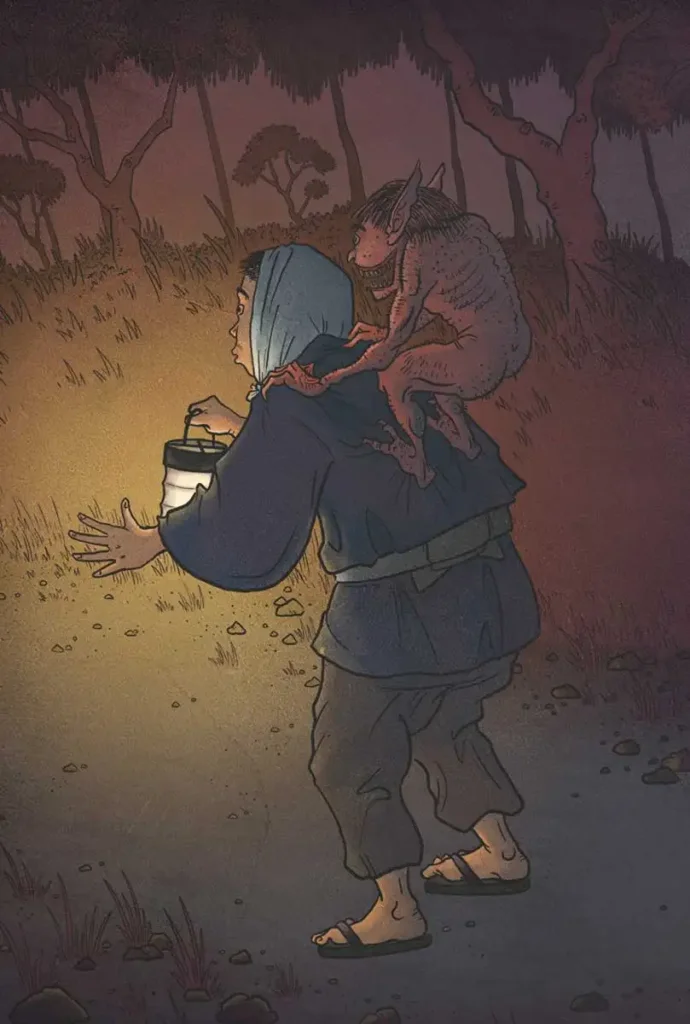
Related article:- 10 scariest cryptids around the world
This is an imp-like yokai who creepily jumps onto the backs of unsuspecting travelers, in a piggyback style. The name comes from a local dialect in Niigata prefecture “Obariyon,” which is a phrase one would say asking for a piggyback ride.
Some versions of the folklore state that this yokai will get heavier and heavier with every step the traveler takes until the weight crushes them and the traveler collapses and faints at that point.
Another version states that if the traveler is strong enough to be able to bear the weight of the Obariyon and keeps moving ahead, it will eventually turn into a sack of gold as a reward.
2. Oni
Related article:- 10 most haunted items in the world that are truly cursed
Oni are iconic and formidable ogres like Yochai, often depicted with grotesque appearances. They have towering humanoid bodies with vividly colored skin, typically red or blue, and are known for their wild manes of hair, sharp claws, horns, and large fangs.
Oni’s fearsome appearances have made them enduring symbols of evil. In Japanese folklore, oni are known for their incredible strength and supernatural abilities. They have the power to control elements like thunder and lightning.
And their immense physical prowess allows them to cause earthquakes and other natural disasters. They are often associated with places where malevolent spirits dwell, and their presence is believed to bring calamity and misfortune.
Countless tales throughout Japanese history feature oni as the antagonists or formidable challenges for heroes. One famous story tells of Momotaro, a heroic figure who embarks on a quest to defeat an army of only terrorizing the land.
He fights fiercely, and the Oni yielded, offering Momotaro all their stolen gold jewels and treasures in exchange for their lives. In Japanese folklore, Yokai played a vital role in explaining the mysteries of the world and phenomena beyond comprehension.
1. Yurei
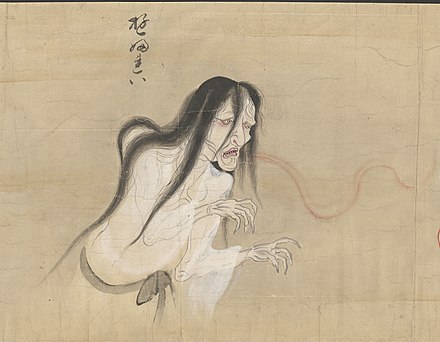
Related article:- 10 scariest sleep demons and ghosts to give you sleepless nights
In Japanese legends, all humans have a soul, unless the soul is respected and the rituals are performed, then they will become vengeful Yurei (ghost).
Yurei are generally the ghosts of dead people. These evil spirits are able to do menacing things in the physical world, such as haunt buildings/people, and kill, to get revenge for the wrongs they faced when they were living.
A Yurei often resembles her former self, but in a death-like avatar, which is pale-skinned, with long, black hair, arms dangling by her side, and wearing a white kimono, a burial gown used in funeral rituals.
If the contemporary Japanese folklore and mythology horror could be summarized by a single Yokai, then that Yokai would be the Yurei.
So did we miss out on any of your favorite Yokai from this list of Japanese mythology and folklore? Comment below and we might add that Yokai from Japanese mythology and folklore.
